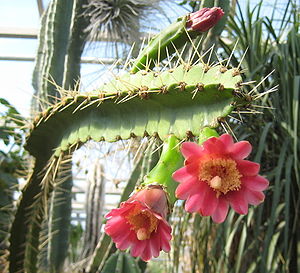Calymmanthium substerile
| Calymmanthium substerile | ||||||||||||
|---|---|---|---|---|---|---|---|---|---|---|---|---|

Calymmanthium substerile in the Dresden Botanical Garden |
||||||||||||
| Systematics | ||||||||||||
|
||||||||||||
| Scientific name of the tribe | ||||||||||||
| Calymmantheae | ||||||||||||
| RSWallace | ||||||||||||
| Scientific name of the genus | ||||||||||||
| Calymmanthium | ||||||||||||
| F. Knight | ||||||||||||
| Scientific name of the species | ||||||||||||
| Calymmanthium substerile | ||||||||||||
| F. Knight |
Calymmanthium substerile is the only plant species of the monotypic genus Calymmanthium in the tribe Calymmantheae of the cactus family(Cactaceae). The botanical name of the genus is composed of the Greek κάλυμμα kalymma for 'coating' and ἄνθος ánthos for 'blossom' and refers to the vegetable tissue that envelops the flower bud. The epithet of the species was probably chosen by Ritter because the plant he discovered first was a single specimen without fruit.
description
The plants grow shrub- to tree-shaped, with many more or less upright shoots and reach heights of up to 8 m. The shoots themselves are segmented, light green and up to a meter long and 4 to 12 cm in diameter. 3 to 4 thin, wing-like ribs are formed, which are noticeably notched. 1 to 6 strong, straight and whitish central spines sit on the clearly visible areoles, which are 3 to 6 mm in diameter . These become up to 5 cm long. In addition, 3 to 8 0.5 to 1 cm long radial spines are formed per areole.
The plants are night flowering. The flower is narrow-tube to bell-shaped, 9 to 11.5 cm long and 3 to 5 cm in diameter. The outer petals are reddish to brown, the inner ones white. The pericarpel and the flower tube are covered with small scales and woolly areoles. Fleshy, light green fruits are formed that do not tear when ripe. The gray-black seed is 2.5 × 1.5 mm in size and matt.
Distribution, systematics and endangerment
The species was discovered on August 8, 1954 by Friedrich Ritter on his first trip to the Marañón . In 1958 Ritter provisionally created a new genus for the plant, Diploperianthium (German = double hull, referring to the veiled flower tube). However, this description is invalid according to the rules of the ICBN. In 1962 it was first described in Cacti and Other Succulents , the magazine of the German Cacti Society . In 1966, Ritter described a second species in the genus Calymmanthium , namely Calymmanthium fertile . However, this species is synonymous with the species described first.
Due to similarities in habitus, Ritter suspects a relationship of the genus to Dendrocereus . However, the seeds of Calymmanthium also have a great similarity to Corryocactus , which suggests a relationship.
The plants have their distribution in Peru , on the lower reaches of the Río Huancabamba in the Amazonas and Cajamarca regions .
In the Red List of Threatened Species of the IUCN , the species is listed as " Least Concern (LC) ". H. listed as not endangered.
proof
literature
- Edward F. Anderson : The Great Cactus Lexicon . Eugen Ulmer KG, Stuttgart 2005, ISBN 3-8001-4573-1 , p. 98 .
- Friedrich Ritter: Cacti in South America . Volume 4: Peru, Friedrich Ritter Selbstverlag, 1981.
Individual evidence
- ↑ F. Ritter: Succulenta , Heft 8, 1966, p. 117.
- ↑ Calymmanthium substerile in the Red List of Endangered Species of the IUCN 2013.2. Posted by: Ostalaza, C., Cáceres, F. & Roque, J., 2011. Retrieved December 31, 2013.